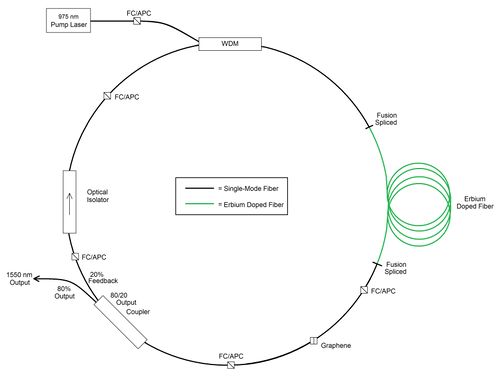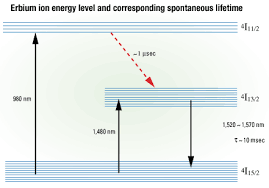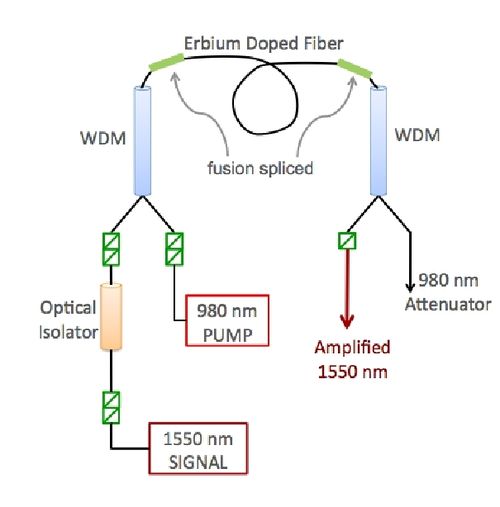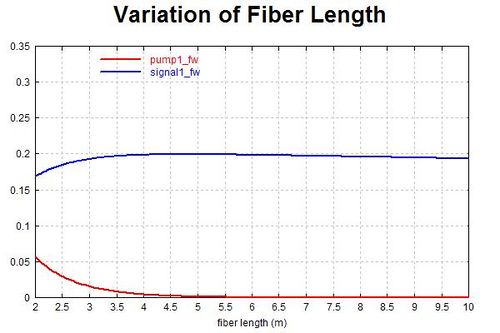Difference between revisions of "Master Oscillator Power Amplifier Pulsed Laser"
Aplstudent (talk | contribs) |
Aplstudent (talk | contribs) (→Erbium-doped fiber amplifier) |
||
| (15 intermediate revisions by the same user not shown) | |||
| Line 1: | Line 1: | ||
| − | + | == MOPA (Master Oscillator Power Amplifier) == | |
| + | |||
| + | [http://www.rp-photonics.com/master_oscillator_power_amplifier.html?s=ak MOPA] | ||
The master oscillator produces a highly coherent beam, and an optical amplifier is used to increase the power of the beam while preserving its main properties. The master oscillator has no need to be powerful, and has no need to operate at high efficiency because the efficiency is determined mainly by the power amplifier. | The master oscillator produces a highly coherent beam, and an optical amplifier is used to increase the power of the beam while preserving its main properties. The master oscillator has no need to be powerful, and has no need to operate at high efficiency because the efficiency is determined mainly by the power amplifier. | ||
| Line 17: | Line 19: | ||
A MOPA can be sensitive to back-reflections, which are amplified again before entering the master laser. This feedback sensitivity can often be cured only by placing a Faraday isolator behind the amplifier. Particularly for high-power pulsed devices, this can introduce serious limitations. | A MOPA can be sensitive to back-reflections, which are amplified again before entering the master laser. This feedback sensitivity can often be cured only by placing a Faraday isolator behind the amplifier. Particularly for high-power pulsed devices, this can introduce serious limitations. | ||
| − | + | == Stages of the fiber laser == | |
1st: Master Oscillator (this is the stage that will contain the graphene and will produce the pulsing) | 1st: Master Oscillator (this is the stage that will contain the graphene and will produce the pulsing) | ||
| Line 25: | Line 27: | ||
3rd: Double-Clad Power Amplifier | 3rd: Double-Clad Power Amplifier | ||
| − | Master Oscillator with graphene as saturable absorber | + | == Master Oscillator with graphene as saturable absorber == |
| − | [ | + | [http://www.rp-photonics.com/master_laser.html Master Laser] |
| + | A master laser is a single-frequency seed laser which is used for, e.g., injection locking of one or several slave lasers. | ||
| − | The | + | A master laser often generates an optical power which is well below the output power of the complete laser system; the injection-seeded slave lasers may then be high-power lasers. The modest power requirements for the master laser make it possible to realize a very low level of laser noise, which may be more or less transferred to the whole system. Also, a larger range for wavelength tuning may be accomplished. |
| − | [[File: | + | [[File:MasterOscillator.jpg|500px]] |
| + | The system is a ring cavity with Erbium doped fiber as the lasing medium. The pump laser is moderate power 975 nm diode laser, and there is 20% feedback in the system to stimulate the emission. We have a graphene saturable absorber to accomplish pulsed operation of the master laser. The 80% output of 1550 nm light is then passed on to the first stage of the power amplifier. | ||
| − | + | == Erbium-doped fiber amplifier == | |
| − | + | [http://www.rp-photonics.com/erbium_doped_fiber_amplifiers.html Erbium-doped Fiber Amplifiers] | |
| − | + | [[File:ErSE.png|thumb|500px|Pumping of Er 3+ by 980-nm light and stimulated emission in the 1.5-μm region]] | |
| − | + | Erbium-doped fiber amplifiers are the by far most important fiber amplifiers in the context of long-range optical fiber communications; they can efficiently amplify light in the 1.5-μm wavelength region, where telecom fibers have their loss minimum. | |
| − | + | [[File:EDFA.jpg|500px]] | |
| − | + | The 1550-nm signal enters initial Wavelength Division Multiplexer (WDM) from the output of the master oscillator, as well as the 980-nm pump signal from the high power diode. The 980-nm signal pumps the Er-doped fiber and the 1550-nm signal stimulates the emission of the 1550-nm photons. This produces signal amplification in the 1.5-μm wavelength region. After passing the final WDM, the 980-nm signal is dumped whereas the 1.5-μm signal is passed to the next stage of the amplifier. | |
| − | + | == Length of fiber == | |
| − | + | The lengths of Erbium-doped fiber are chosen based on RP Fiber Power simulation: | |
| − | [[File: | + | [[File:FiberLength.jpg|500px]] |
| − | |||
| − | |||
| − | |||
| − | |||
| − | |||
| − | |||
| − | |||
| − | |||
| − | |||
| − | |||
| − | |||
| − | |||
| − | |||
| − | |||
| − | |||
| − | |||
| − | |||
| − | |||
| − | |||
| − | |||
| − | |||
| − | |||
| − | |||
| − | |||
| − | |||
| − | |||
| − | |||
| − | |||
| − | |||
| − | |||
| − | |||
| − | |||
| − | |||
Latest revision as of 15:04, 19 June 2015
Contents
MOPA (Master Oscillator Power Amplifier)
The master oscillator produces a highly coherent beam, and an optical amplifier is used to increase the power of the beam while preserving its main properties. The master oscillator has no need to be powerful, and has no need to operate at high efficiency because the efficiency is determined mainly by the power amplifier.
With a MOPA instead of a laser, it can be easier to reach the required performance e.g. in terms of linewidth, wavelength tuning range, beam quality or pulse duration if the required power is very high. This is because various performance aspects are decoupled from the generation of high powers. This gives extra flexibility, e.g. when a gain-switched laser diode is used as a seed laser.
The same aspects apply to other kinds of modulation, e.g. intensity or phase modulation: it may be advantageous to modulate the low-power seed laser, or to use an optical modulator between seed laser and power amplifier, rather than to modulate a high-power device directly. Slower power modulation may be done by adjusting the amplifier's pump power, without significantly affecting e.g. the obtained pulse duration or wavelength.
The combination of an existing laser with an existing amplifier (or an amplifier chain) may be simpler than developing a new laser with higher output power.
The optical intensities are lower in an amplifier, compared with the intracavity intensities in a laser.
However, the MOPA approach can also have disadvantages:
The resulting laser noise tends to be higher, since an amplified source can not reach the shot noise level (→ amplifier noise). Effects of drifts of the seed power may be suppressed, however, if the amplifier is operated in a strongly saturated regime.
A MOPA can be sensitive to back-reflections, which are amplified again before entering the master laser. This feedback sensitivity can often be cured only by placing a Faraday isolator behind the amplifier. Particularly for high-power pulsed devices, this can introduce serious limitations.
Stages of the fiber laser
1st: Master Oscillator (this is the stage that will contain the graphene and will produce the pulsing)
2nd: Single-Mode Power Amplifier
3rd: Double-Clad Power Amplifier
Master Oscillator with graphene as saturable absorber
A master laser is a single-frequency seed laser which is used for, e.g., injection locking of one or several slave lasers.
A master laser often generates an optical power which is well below the output power of the complete laser system; the injection-seeded slave lasers may then be high-power lasers. The modest power requirements for the master laser make it possible to realize a very low level of laser noise, which may be more or less transferred to the whole system. Also, a larger range for wavelength tuning may be accomplished.
The system is a ring cavity with Erbium doped fiber as the lasing medium. The pump laser is moderate power 975 nm diode laser, and there is 20% feedback in the system to stimulate the emission. We have a graphene saturable absorber to accomplish pulsed operation of the master laser. The 80% output of 1550 nm light is then passed on to the first stage of the power amplifier.
Erbium-doped fiber amplifier
Erbium-doped fiber amplifiers are the by far most important fiber amplifiers in the context of long-range optical fiber communications; they can efficiently amplify light in the 1.5-μm wavelength region, where telecom fibers have their loss minimum.
The 1550-nm signal enters initial Wavelength Division Multiplexer (WDM) from the output of the master oscillator, as well as the 980-nm pump signal from the high power diode. The 980-nm signal pumps the Er-doped fiber and the 1550-nm signal stimulates the emission of the 1550-nm photons. This produces signal amplification in the 1.5-μm wavelength region. After passing the final WDM, the 980-nm signal is dumped whereas the 1.5-μm signal is passed to the next stage of the amplifier.
Length of fiber
The lengths of Erbium-doped fiber are chosen based on RP Fiber Power simulation:



